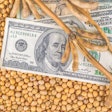In the September World Agricultural Supply and Demand Estimates (WASDE) report, the U.S. Department of Agriculture (USDA) forecast 2013-14 marketing year exports at 1.225 billion bushels for corn and 1.37 billion bushels for soybeans, said University of Illinois agricultural economist, Darrel Good.
“The strong pace of exports and especially export sales so far this year has created expectations of larger forecasts in the WASDE report to be released on November 8,” said Good.
As of October 31, the USDA reported that cumulative corn export inspections for the marketing year beginning September 1 totaled 206.7 million bushels. Cumulative inspections were 30 percent larger than the previous marketing year and represented 17 percent of the current USDA projection for the year, he said.
Cumulative export commitments (exports plus unshipped export sales) as of October 24 were reported at 808 million bushels. Those commitments were 88 percent larger than commitments of the previous marketing year and represented 66 percent of the USDA projection for the year.
“Compared to commitments of a year ago, commitments this year are 138 million bushels larger for China, 125 million larger for Mexico, and 88 million bushels larger for unknown destinations. Sales to China represent nearly 22 percent of the total sales, compared to only 8 percent last year,” Good said.
As of October 31, the USDA reported that cumulative soybean export inspections for the marketing year that began on September 1 totaled 338.5 million bushels. Cumulative inspections were 9 percent smaller than those of the previous year and represented 25 percent of the current USDA projection for the year, he said.
Cumulative export commitments as of October 24, however, were reported at 1.184 billion bushels. Those commitments were 25 percent larger than commitments of a year earlier and represented 86 percent of the USDA projection for the year, according to Good.
“Compared to commitments of a year ago, commitments this year are 160 million bushels larger for China and 51 million larger for unknown destinations. About 14 million bushels have been sold to Russia, compared to none last year. Sales to China represent 62 percent of the total sales compared to 61 percent last year,” Good noted.
Export sales of corn and soybeans have been quite large early in the marketing year, but Good says the question is: “Is early-year export activity a good predictor of total marketing year exports? The short answer is no,” he said.
According to Good: “Seasonal export shipment and sales patterns vary considerably from year to year. Over the 10 years from 2003-04 through 2012-13, for example, corn exports during the first quarter of the marketing year averaged 26 percent of the total for the year but ranged from 22 to 30 percent. The pattern of sales was even more varied. Cumulative export sales at the end of the first quarter of the marketing year averaged 49 percent of the total exports for the marketing year but ranged from 36 to 66 percent.”
Good said that soybean exports during the first quarter of the marketing year averaged 36 percent of the total for the year but varied from 28 to 47 percent. As with corn, the pattern of sales was even more varied. Cumulative export sales at the end of the first quarter of the marketing year averaged 63 percent of the total exports for the marketing year, but ranged from 48 to 82 percent.
“While the magnitude of export sales early in the marketing year is not generally a good predictor of marketing-year exports, cumulative sales so far this year are still unusually large relative to the USDA’s September export forecast for the year,” he said.
As mentioned before, after the eighth week of the marketing year, corn sales equal 66 percent of the USDA projection. That equals the largest percentage experienced after the thirteenth week of the marketing year in the previous 10 years. Similarly, soybean sales at the end of the eighth week represent 86 percent of the USDA projection for the year. That exceeds the largest percentage experienced after the thirteenth week of the marketing year in the previous 10 years, he said.
“With a very large corn crop, U.S. corn exports may well exceed the current projection of 1.225 billion bushels. Larger exports would in turn result in smaller year-ending stocks than would otherwise occur but would probably not result in higher corn prices. Instead, large exports are likely dependent on corn prices remaining relatively low,” Good said.
According to Good, if soybean exports are to exceed the current projection of 1.37 billion bushels, the U.S. crop may have to exceed the current forecast of 3.149 billion bushels because year-ending stocks are already projected to be small.
“As a result, there is some chance that soybean prices will have to remain high enough to limit consumption in the face of strong export demand. The size of the USDA’s November 8 crop forecast will determine to a large extent whether or not such rationing is required,” he said.
















